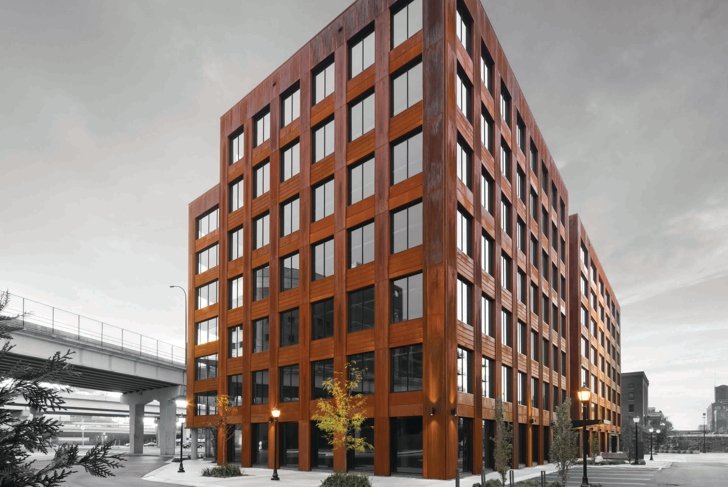
We live in them. We work in them. And our planet’s getting warmer because of them.
The buildings we inhabit are major contributors to climate change—accounting for nearly 40 percent of global greenhouse gas emissions.
That’s largely due to the energy used to heat and cool them, but a portion of buildings’ carbon contribution is generated at the construction stage. Producing (and then building with) materials like concrete and steel dumps 11 percent of global carbon dioxide emissions into the atmosphere.
But Vancouver, Canada-based architect Michael Green has a vision for making buildings’ structures not only carbon-neutral, but also carbon sinks. It involves swapping concrete and steel for what he considers to be the ultimate green building material: wood.
Coming out of the woodwork
Green explains that wood can be just as strong and versatile as manmade building materials, yet the production of the raw material creates no emissions because it’s “grown by the power of the sun.” What’s more, wood “sequesters carbon dioxide,” which means wood buildings store carbon that otherwise would be released into the atmosphere when trees die and decay. Plus, wood is an easily renewable resource.
Wood fell out of favor as a material for tall buildings in the late 19th century, when massive fires ravaged timber structures in cities like Chicago. But as wood building materials have become more firesafe, Green’s architectural firm, Michael Green Architecture (MGA)—which was founded in 2012 and acquired by tech-driven construction giant Katerra in 2018—has helped revive tall wood building construction around the world.
MGA’s Wood Innovation and Design Centre (WIDC) is an eight-story building in British Columbia, Canada, that opened in 2014 as the tallest modern wood structure in North America. It was one of the first game changers in tall wood construction. “We showed that it could be built affordably, it could be beautiful, and that we could use 100 percent wood,” Green says.
Safety first
WIDC was built with cross-laminated timber (CLT), which isn’t like the lumber you find at your local hardware store. Rather, CLT consists of several layers of wood stacked in alternating directions and bonded with adhesives to form solid rectangular panels. CLT is sturdy yet lightweight, and in the event of a fire, the panels burn relatively slowly, which can allow for even greater fire resistance than steel.
Additionally, in all the buildings that MGA designs, “The [internal] structure is protected by other materials that are non-combustible,” Green says. For example, WIDC is externally clad in charred Western red cedar siding that’s resistant to flames.
Seeing the forest for the trees
Building with CLT also has benefits from a forest-protection standpoint. Instead of cutting down old-growth trees, “We’re using smaller trees and gluing them together to make these big panels,” says Green. MGA takes care to source its wood exclusively from Forest Stewardship Council-certified forests, which are responsibly managed.
In WIDC and other MGA wood buildings—including T3, a seven-story Minneapolis office tower that in 2016 became the first modern tall wood building in the US—interior wood panels are left exposed. This creates a setting that’s not only aesthetically appealing, but that also “encourages human health and happiness,” says Green. “Employees in a workplace are more productive and have [fewer] sick days if they work in a wood environment.”
Hammering it home
Given the varied benefits of wood buildings for human thriving, Green is invested in scaling up wood building projects by spearheading innovations in the construction process. That’s one of the reasons MGA partnered with Katerra, which manufactures large building components in factories, allowing buildings to be erected more quickly and inexpensively.
Green’s hope is that making wood construction cheaper and faster will allow architects and builders to help ease what he calls the “massive human need for housing,” which is a driver of crises of homelessness and unaffordability in cities around the world.
Because housing shortages and climate change are such urgent issues, Green says, “This is no time to rest on our laurels.” The construction of dozens of tall wood buildings in recent years “is a good thing, but it’s not enough. It’s important to be ready for what’s next.”
New heights
This MGA-designed mass timber building, called T3, showcases many environmental benefits.
- T3’s wood structure will sequester about 3,200 tons of carbon for the life of the building.
- The majority of timber used in the project came from trees killed by the mountain pine beetle, sparing healthy forest.
- The building earned LEED Gold certification and incorporates energy-efficient systems aimed at reducing building operations emissions.
Rachel B. Levin is a Los Angeles-based freelance writer covering food, health, and sustainability. Follow her on Instagram: @rachelbethlevin.
























